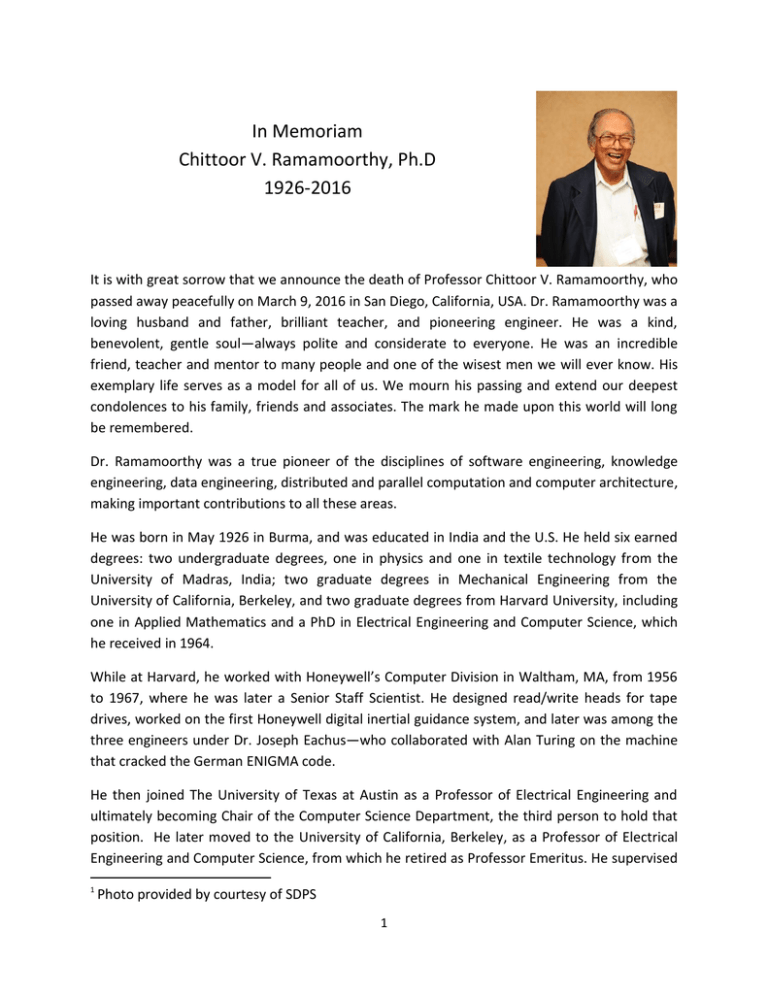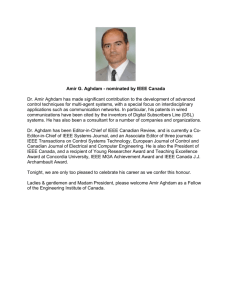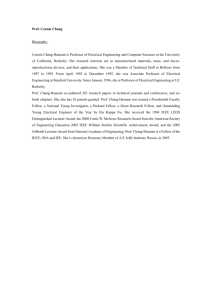In Memoriam Chittoor V. Ramamoorthy, Ph.D 1926-2016
advertisement

1 In Memoriam Chittoor V. Ramamoorthy, Ph.D 1926-2016 It is with great sorrow that we announce the death of Professor Chittoor V. Ramamoorthy, who passed away peacefully on March 9, 2016 in San Diego, California, USA. Dr. Ramamoorthy was a loving husband and father, brilliant teacher, and pioneering engineer. He was a kind, benevolent, gentle soul—always polite and considerate to everyone. He was an incredible friend, teacher and mentor to many people and one of the wisest men we will ever know. His exemplary life serves as a model for all of us. We mourn his passing and extend our deepest condolences to his family, friends and associates. The mark he made upon this world will long be remembered. Dr. Ramamoorthy was a true pioneer of the disciplines of software engineering, knowledge engineering, data engineering, distributed and parallel computation and computer architecture, making important contributions to all these areas. He was born in May 1926 in Burma, and was educated in India and the U.S. He held six earned degrees: two undergraduate degrees, one in physics and one in textile technology from the University of Madras, India; two graduate degrees in Mechanical Engineering from the University of California, Berkeley, and two graduate degrees from Harvard University, including one in Applied Mathematics and a PhD in Electrical Engineering and Computer Science, which he received in 1964. While at Harvard, he worked with Honeywell’s Computer Division in Waltham, MA, from 1956 to 1967, where he was later a Senior Staff Scientist. He designed read/write heads for tape drives, worked on the first Honeywell digital inertial guidance system, and later was among the three engineers under Dr. Joseph Eachus—who collaborated with Alan Turing on the machine that cracked the German ENIGMA code. He then joined The University of Texas at Austin as a Professor of Electrical Engineering and ultimately becoming Chair of the Computer Science Department, the third person to hold that position. He later moved to the University of California, Berkeley, as a Professor of Electrical Engineering and Computer Science, from which he retired as Professor Emeritus. He supervised 1 Photo provided by courtesy of SDPS 1 73 PhD students over the course of his career, serving as both advisor and mentor. His generous and exemplary mentorship is reflected in the fact that his students include a Vice Chancellor, 3 University Presidents, and a President of the IEEE Computer Society, as well as several Deans, Department Chairs, Chair Professors, and CEOs. Prof. Ramamoorthy’s research accomplishments span several important areas of Computer Science, including synthesis of parallel programs, optimal organization and scheduling of parallel programs, recovery and roll-back techniques for enhancing the dependability of distributed systems, automated simulation and testing of safety-critical systems, and other innovative research projects. His research contributions have had significant impact on enhancing the dependability of safety-critical distributed real-time embedded systems. For example, in the late 1960’s, Prof. Ramamoorthy and his students developed an automated test generation and evaluation system which discovered several programming errors in the U.S. Army’s Safeguard Missile Defense System. Updated versions of these tools were used in 1971 at NASA’s Space Shuttle Structural Test Facility in Huntsville, AL, to rigorously test the Space Shuttle System. Earlier, he was responsible for the development of the entire microcode for instruction sequencing and control of the first transistorized system of Honeywell, the H-290, in 1961. The H-290 was a general purpose, stored-program digital computer designed for process monitoring and control. Later, he conducted research on functions, features, and control in the service industries and showed the close and enduring relationships between software engineering and service engineering. He published more than 200 papers and co-edited three books: The Handbook on Software Engineering, Pacific Computer Communications, and Computers for AI Processing. Throughout his career, he has been an exemplary transdisciplinary innovator who is always at the cross-sections to invent the future. Prof. Ramamoorthy was very active in IEEE and the computing community throughout his career. He was a Life Fellow of the IEEE. In addition, he was elected first Vice President of the IEEE Computer Society, and was its very first Vice President of Education as well as the Education Chair of the American Federation of Information Processing Societies (AFIPS). He served as the Founding Editor-in-Chief of this very journal and served as the Editor-in-Chief of the IEEE Transactions on Software Engineering. He was the Editor-in-Chief of the International Journal of Software Engineering and Artificial Intelligence, and the founding Co-Editor-in-Chief of the International Journal of Systems Integration and the Journal of the Society of Design and Process Science. He was also involved in numerous conferences: he served as the Co-General Chair of the Second International Conference on Software Engineering (ICSE) in 1976 and as the cofounder of the IEEE Symposium on Reliable Distributed Systems (SRDS) in 1981 and the IEEE International Conference on Data Engineering (ICDE) in 1985. In addition, he served on many advisory committees, including those of the U.S. Army, Air Force, and Navy, Los Alamos Labs, Lockheed Research, and IBM. 2 He received many awards from the IEEE and the IEEE Computer Society: the IEEE Golden Core Recognition Award in 1966, the IEEE Computer Society Honor Roll Award in 1974, the IEEE Computer Society Special Education Award in 1978, the Group Award in Education for Curriculum Development, the IEEE Computer Society Taylor Booth Award in 1990 for outstanding contributions to education, the Richard E. Merwin Distinguished Service Award in 1993 for his outstanding professional contributions, and the Golden Core Recognition given to Society members for their long-standing contributions and outstanding service. He was among the select few of IEEE's large membership to receive both the IEEE Centennial Medal in 1984, which marked the first hundred years of this great organization, and the IEEE Third Millennium Medal in 2000. In 2001, he was awarded the IEEE Computer Society's Hitachi-Kanai Award for fundamental contributions in parallel and distributed computing. He also received numerous other awards in the computing community. These include the Distinguished Scholar Award from the Society for Design and Process Science (SDPS) in 1995, Control Data Distinguished Professorship at the University of Minnesota, MN, Grace Hopper Chair at the U.S. Naval Postgraduate School in Monterrey, CA, Senior Research Fellow at the ICC Institute of the University of Texas, Austin, TX, Academy Gold Medal of Honor Award from the Academy of Transdisciplinary Learning and Advanced Studies (ATLAS) in 2002 and a Fellow of ATLAS and Fellow of SDPS. He received several SDPS awards beginning with the Raymond T. Yeh Distinguished Achievement Award in 2002, followed by the Herbert Simon Award in 2006. In 2006, SDPS established the Ramamoorthy-Yeh Endowment, named after Prof. Ramamoorthy and his close associate and life-long friend Prof. Raymond T. Yeh, in honor of their accomplishments as scientist-engineers. In 2010, SDPS presented Prof. Ramamoorthy its highest award, the SES Transformative Achievement Award, for his outstanding contributions in software engineering. In 2014, he was included in the distinguished list of eight SDPS Visionaries whose far-reaching work and ideas inspired the formation of SDPS. Beneath Prof. Ramamoorthy's calm, unassuming demeanor lay both genius and unwavering integrity. Dr. Ram spread joy wherever he went. He loved to laugh and celebrate life. He traveled extensively throughout his life and was truly admired and respected by his many friends, colleagues, and associates across the world. We will sincerely miss our beloved “Dr. Ram.” May he be remembered forever. 3

